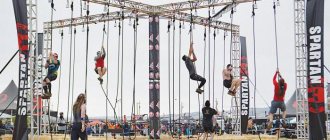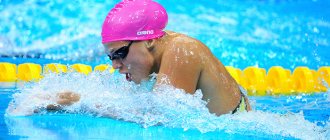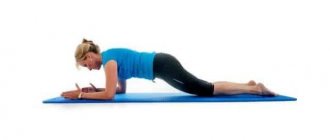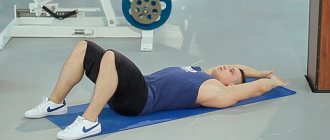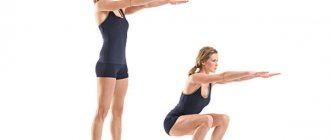Key aspects of working on butterfly style technique
The key aspects of the butterfly style technique include two essential elements - the undulating movement of the body and the arm stroke. They are worked out separately and in combination with each other.
Many highlight the third key point - footwork, however, I consider it a continuation of the wave-like movements of the body. This point of view is quite consistent with the concept of the “front” butterfly technique that is widespread today.
I also recommend reading the article “What muscles work when swimming in a pool?”
Underwater technology
This style is often used not only for moving on the surface of the water, but also for swimming underwater:
- firstly, this way you can dive and swim in open waters;
- secondly, in sports swimming in the pool, the start in both butterfly and freestyle is done by diving under the water and sliding with dolphin footwork.
In order to move as a dolphin underwater, you need:
- Extend your arms like an arrow in front of you. This is the main difference from the “classic” version, in which they are not extended all the time, but make strokes.
- Make wave-like movements with your legs and torso, which are described above in this article.
- Breathing: before diving, you need to take a strong and voluminous breath, then gradually exhale under water - through your nose or both your nose and mouth.
You can see what it looks like here:
Wave-like body movements
The central element, both figuratively and literally, of butterfly style techniques is the undulating movement of the body from head to toe. Sometimes they are compared to the movements of dolphins or a whip, but I believe that they are most similar to the repeated actions of the whole body, reminiscent of a wave in shape.
Beginning with a slight movement of the head and chest, the force increases as it moves “through” the body through the hips and legs and ends with the action of the feet, which generates propulsion throughout the body.
What is Butterfly?
Butterfly is swimming on the chest with simultaneous synchronized movements of the right and left limbs. The swimmer should lift part of the body to the surface and use both hands to make a massive stroke to lift the body above the water.
What is Butterfly?
At the same time, you need to bring your legs together and synchronously perform peculiar strikes with them. From English butterfly is translated as “butterfly”. This style is also sometimes called “Dolphin”, it is among the most exhausting and difficult to perform, but nevertheless it is almost the fastest.
Head position and movement
The head is located in front of the body, cutting through the water during swimming; its position and movement are of the most important nature and require special attention.
It is necessary not only to coordinate the movement of the head with the actions of the hands during inhalation, but also to correctly position it while immersing in water. When tilting your head and immersing yourself in water, the neck muscles should be relaxed and stretched, since water pressure is created on the head tilted down (as a rule, it falls on the area above the forehead), which, in turn, facilitates forward movement.
It is the head that “launches” the wave-like actions of the body with light, repetitive movements or rocking.
The swimmer does not need to make excessive movements with his head, since in this case the neck muscles do not relax, and the water pressure in the area above the forehead does not help the body make forward movement.
As for the inhalation cycle, the head at this moment should deviate as little as possible from the line of forward movement.
Sports start
Athletes observe not only swimming technique, but also proper immersion in water. To do this, you need to stand on the side in the appropriate way for the butterfly style. Here the following sequence is observed:
- In the starting position, standing on the side, the athlete needs to first stand straight and then bend his knees slightly. Then the body is lowered at a right angle - the body is parallel to the water. There is a small distance between the feet - no more than 20 cm.
- Fingers reach the edge line.
- Hands are placed straight, back.
- At the start, the athlete needs to quickly and strongly push off from the boot, while simultaneously putting his hands forward and placing them with his palms. The arms are extended above the head for a smooth descent into the water.
They don’t dive from the side shallowly, but they don’t dive to the bottom either. The athlete must maintain a body tilt of 30 degrees to the surface of the water. They swim underwater, first slightly downwards, then parallel to the surface of the water, and then rise up. If you have problems surfacing, it is recommended to use your hands.
Hips and effective leg action
Probably the most important thing when performing undulating movements of the body is the balance and completeness of the hips, which includes not only vertical movements, but also thrusts of the pelvis.
It is worth noting that their implementation requires coordinated work of the back muscles during vertical movements and the lower abdominal muscles during pelvic thrusts, which illustrates the importance of the general physical endurance and preparation described above. Poor hip action, especially in propulsion, is commonly seen in swimmers who are unable to perform well using their legs alone. And this seems quite logical.
Effective kicking means that the feet, both when lifting and lowering, are in the correct position to generate movement in the water in a line just opposite the desired forward line of motion. This is achieved in part due to the high flexibility of the foot and ankle area. However, proper hip function is necessary to achieve the desired foot angle.
The legs follow the hips as they move up and down. These actions are accompanied by a natural bending of the legs after the movement of the body. Next, the feet take a position in accordance with this wave-like movement of the body. In the absence of forward-directed work of the hips, the wave-like movement of the body is interrupted, and in order for the feet to take the required position at an angle, the swimmer is forced, making special efforts, to bend his legs at the knees, while with the wave-like movement of the body, the legs bend spontaneously.
This is because the feet, being at the very end of a short wave line (from the knees to the feet, and not from the hips to the feet, which would be more correct), as a result require more bending of the knees to get into position at the desired angle.
This sudden movement of the knees results in unnecessary resistance, not to mention additional stress on the athlete's muscles, and reduces the return on energy applied. In short, bending your knees in the correct wave-like motion allows your feet to move into the correct position and reduces the drag of the water.
What is the butterfly style swimming technique? ^
Movement pattern when swimming butterfly style
Hand movements
These movements include three main phases:
To yourself. Palms slightly down at shoulder-width level are immersed in water. Then the arms are spread to the sides.
Push. Describe a semicircle with your arms around the body.
The hands are below the elbows and directed slightly downwards. The movement reaches about a third of the thigh and then returns. The speed of hand movement increases from the beginning to a maximum at the end of the movement.
The highest speed produces a push that throws the front part of the swimmer’s body to the surface.
Return. With a quick movement, the swimmer moves his arms forward, relaxing them. Arms straight at the elbows. This phase begins in the water, after which the body is thrown forward due to contraction of the triceps muscles.
Now again the hands enter the water at shoulder distance. It is not recommended to move your arms in and out, as the stroke decreases and the speed decreases.
Leg movements.
The leg movements are somewhat reminiscent of crawl swimming. However, the legs move simultaneously rather than one at a time, which uses other muscles.
A weak downward movement of the legs and a strong upward movement takes the head and shoulders out of the water. Then, on the contrary, with a weak upward movement and a strong downward movement, the swimmer’s back comes out of the water.
To avoid a decrease in the power of the effort, the legs should always be kept together. Athletes choose the number of kick strokes individually, but more often the cycle consists of two strokes.
Video on practicing butterfly style movements on land:
https://www.youtube.com/watch?feature=player_detailpage&v=ouzgAUCB_Lg
Breath.
In butterfly, the breath is taken for a very short time. You can help yourself by bending your body, but it requires good technique. Inhalation must be done through the mouth.
There is no need to hold your head above the water, otherwise the return movement will slow down. Before the next inhalation, exhale through the mouth and nose.
Athletes resort to different breathing. Some people breathe every other time, while others breathe every other time. There are swimmers who swim short distances without breathing.
Body movements.
In butterfly, the complex coordination of movements is facilitated by correct body movements. When lowering your shoulders down, you need to raise your hips higher.
In this case, the pelvis crosses the water line, due to which a wave seems to pass through the body. The next stage involves lifting the shoulders upward, which keeps the hips down.
Video - what butterfly style swimming looks like directly in the water:
Start.
In the butterfly style there is a traditional start. The athlete enters the water and begins to slide under the water, making wave-like movements with his legs.
This underwater phase is very important because the water resistance is reduced as much as possible. According to the rules, the athlete has the right to swim under water no more than 15 m. Then he must appear on the surface.
Movements when turning
When turning around at a distance, the athlete touches the side with both hands. More often, the arms are slightly bent to push away from the side.
First, the arm unfolds, then the legs reach the side, and the other arm unfolds. The swimmer’s torso sinks even deeper into the water, and the chest is as parallel to the bottom as possible.
Then a push. In this place you are allowed to swim no more than 15 m, as at the start. Many swimmers make vertical strokes with their legs underwater, trying to increase their speed.
Foot push is the final stage of body movement
The thrust of the feet generates the driving force at the end of the wave-like movement. This push engages the potential of the feet (which are positioned at the correct angle), quadriceps, and hamstrings.
This push can be seen as a source of additional driving force or an additional explosive movement that completes the body wave, like the blow of a whip or an exclamation mark at the end of a sentence. In any case, the effectiveness of the push depends on the correct execution of the wave-like movement of the body.
However, there is one very important point - the swimmer needs to monitor the proportionality of the push, since too strong actions of the feet can cause a very strong body wave or excessive bending of the legs at the knees.
The push should be uniform, but at the same time sharp. The negative effects of excessive pushing will be discussed later in this article on pushing coordination and hand work. Below, the term “push” or “leg movement” will be understood as a complete wave-like movement, including the push of the feet at the end of the wave.
Although foot propulsion may seem to depend on the body's wave motion, practicing foot propulsion remains a very important part of a butterfly swimmer's training program. Their special training with the help of special exercises allows you to increase the endurance of the leg muscles, increase the flexibility of the feet and ankles and influences the correct functioning of the hips during wave-like movements.
These exercises can be performed in different positions - on the back, side or stomach using a variety of tools, including boards of different sizes and long, short fins and monofins. Trainers should use monofins regularly, as this can significantly increase the effectiveness of training. Swimming with them helps to master the wave-like movements of the body (especially with the hips), increases the flexibility of the foot, develops the endurance of different muscle groups and streamlines the body.
The sets of exercises described below are designed to help improve the shape of the leg muscles and master or improve the undulating movements of the body and the correct technique of butterfly swimming.
History of the butterfly style
Originally there were only three swimming styles: freestyle, backstroke and breaststroke. The butterfly arose from the “modernization” of the breaststroke. The hands began to move above the water, which accelerated the swimmer’s progress. And then they changed the movement of the lower extremities to a more natural one.
In 1933, Henry Myers swam at the Brooklyn Central YMCA Championships with a style reminiscent of a dolphin. Iowa varsity swim coach David Armbruster researched breaststroke. In 1934, Armbruster improved the method and moved the arms forward above the water surface during breaststroke. He gave the name to the new style - “Butterfly”.
Despite the difficulty of the style, there was a significant increase in speed. A year later, in 1935, swimmer Jack Sieg, also from the University of Iowa, was able to develop a stroke technique that involved swimming on his back and kicking his legs in unison, like a fish kicking its tail. Then I changed my technique to swim face down. He gave the name to this style - “dolphin”. Sieg and Armbruster immediately realized that combining the two techniques would create a very fast swimming style.
For better coordination of movements, find out the best exercises on a jump rope.
Here is an article about cardio training at home.
Yoga for beginners at home. https://stroy-telo.com/domashnij-trening/stretching/joga-dlya-nachinayushchikh-zanimaemsya-doma-samostoyatelno.html
Exercises
— A series of swims of 3 x 200 meters, the body is extended or moving on the stomach with a board, increasing activity as swims 1-3, 4-6, 7-8 are completed.
— A series of swims of 3 x 100 meters, arms down, covering the distance at maximum speed, best average time.
Movement on the side. The lower arm is extended, the upper arm is lowered, alternating movements of the sides. This exercise allows you to work your hips behind or in front of an imaginary center line of the body.
Working with monofins. Performing pushes for 25 meters, followed by a short rest break, a series of swims of 3 x 100 meters, every 25 or 15 meters movement under water with an extended body position (alternating actions on the back and on the stomach) plus movement on the side, alternating left and right when turning over.
Vertical leg movements with load. Practicing straight vertical movements and balanced hip work.
Push and swim. A series of swims of 3 x 100 meters, the swimmer completes 50 meters using only his legs / 50 meters in the butterfly style, followed by a rest period, gradually increasing the load 1-3, 4-6, 7-8 (the sixth swim must be completed faster than the third, the eighth faster sixth).
Start. You need to do 25 repetitions; odd-numbered swims are performed underwater using only the legs, even-numbered swims are performed in the butterfly style.
Movement only with legs, arms down. The exercise is done in a mask and snorkel with or without monofins. It develops the skills of relaxing the neck muscles in the presence of water pressure, which is created by the forward movement of the head, despite its slight swaying.
Butterfly exercises in water
In addition to training on land, it is important to perform exercises in water:
- perform strong kicks alternately in the water - you can do this while swimming on your back, stomach or side;
- vertical kicks simultaneously with both legs back and forth;
- swims with one active arm - in this case, the arm that does not take part in the movement is pressed to the body.
Only regular training will give the required result. Also useful are video lessons for beginners, which clearly show the movements of the butterfly style swimming technique.
Hand cycle
The second key point of the butterfly style technique is the cycle of arm movement.
The immersion of both hands in the water follows a recovery period that accompanies the “flying” of the hands out of the water. These actions, together with wave-like movements of the body, constitute the essence of the butterfly style swimming technique. Over the years since the advent of the butterfly stroke, many successful swimmers have demonstrated a wide variety of variations on the basic technique.
Today the most popular is the “front” butterfly technique. In fact, this variation is characterized by focusing on the first part of the stroke or shifting the attention from the area behind the hips (i.e. the legs) to the area before the hips (the upper body). Various characteristics of this style of swimming have been successfully developed and demonstrated by outstanding swimmers and world record holders - Denis Pankratov, Michael Klim and Jenny Thompson. The evolution of Thompson's technique is particularly illustrative of the development of butterfly style technique.
Training rules
A sport like swimming requires regular practice, and if you intend to learn the butterfly technique, you will have to start small, gradually complicating the exercises.
Any workout always begins with a warm-up, and it should be done not in the pool, but before diving into the water. 10 minutes is enough to warm up the muscles and prepare them for further stress.
Our swimming style requires careful study, but even if you understand exactly how to swim butterfly, you cannot avoid mistakes in the first couples.
It is important to start the movement correctly, control the position of the body, arms and legs when turning, and maintain synchronization of movements. You should also not forget about breathing; it should not be knocked down and the pulse should not be rapid.
Initial phase of the hand cycle
We will begin our analysis of the arm work characteristic of the butterfly style from the top of the cycle: the hands are extended above the head, the arms are located within the imaginary boundaries coming from the swimmer’s shoulders. From this position, the arms move in pairs forward and down. The force of the forward movement decreases as the point directly in front of the shoulder line is reached.
The arms complete the downward movement at a point located below the corresponding level of the elbows, while the fingertips rotate downward towards the bottom of the pool. At the same time, the palms turn inward, thus positioning themselves along the swimmer's line of motion. This is what the ideal hand position looks like in the “grabbing” position.
After slightly relaxing your arms and bending them at the elbow, the power phase of the stroke begins. It is accompanied by the withdrawal of the arms to a line located directly opposite the intended front line of movement. As the arms move along the chest line, the force of direct pushing of the arms back decreases, the hands turn inward, and the lines of movement of the arms practically intersect at a point just behind the chest line. At this moment, the palms turn and the straight stroke of the arms, which are now close to each other, is resumed.
It is best to start this stroke earlier (approximately at the chest line) rather than later. Moving your arms under your chest makes it easier and faster for them to come out of the water in the final stage of the stroke, which, in turn, reduces the load. The arms maintain an ideal angle for a sufficiently long continuous period of time, as a result the swimmer is able to perform a quick and more efficient release of them from the water. A late stroke leaves less time for “accumulation” of forces to withdraw and restore the arms, which leads to them “sticking” at depth or to an ineffective long stroke.
Movement of the body in the “dolphin” way
During the process of swimming, a person’s torso constantly moves up and down, all movements are associated with breathing and the work of the limbs.
The starting position is a straight body, legs folded together, arms extended above the head. Next, for beginner swimmers, we will consider separately the technique of working all parts of the body.
As the shoulders and upper back move forward and down, the lower back and pelvis lift while the feet swing downward. Conversely, as the shoulder girdle rises, the lower back lowers and the feet rise towards the surface to make the impact.
Wave-like body movement
The body should make wave-like movements, primarily due to the tension of the abdominal and back muscles. From the observer's side, the swimmer's body moves along a wave-like trajectory, making him look like a dolphin or fish.
Pushing hands and exiting the water
Based on all the information presented above, the next question logically arises: at what point should you reduce the force applied to perform the stroke, and when should you remove your hands from the water? The arms should push until maximum driving force is maintained just before the natural lift of the fingers, which occurs at the bottom of the stroke.
Once the toes begin to rise, the swimmer lowers the hips, leaving the arms unable to generate propulsive force by pushing through the water. Removing the arms from it during a “late” stroke is delayed, since the athlete does not have enough time to accumulate the forces required for a quick and effective transition to the recovery phase.
When using the "front" technique of the butterfly style, the arms push the water only to the end point, allowing maximum driving force to be generated rather than wasting energy on an inefficient long stroke. It is also worth noting that thanks to the early stroke, the swimmer has the opportunity to build up the strength to quickly and efficiently remove the arms from the water and enter the recovery phase.
Execution technique
Let's move on to analyzing the correct butterfly swimming technique for beginners. We will explain it clearly and as simply as possible. We also recommend searching for instructional videos on YouTube to clearly see the anatomy of the movements.
The butterfly swimming technique includes 3 sub-points: movements of the arms, legs and torso, breathing.
Starting position: the swimmer lies on the water with his stomach down, his arms are straightened forward, his legs are extended back, brought together.
Hand movements
The cycle consists of three stages:
- First, the hands are immersed in the pool, palms facing down. Limbs are spread to shoulder width;
- Next, the hands move the water in a circular motion around the athlete’s body, approximately to the hip line. The elbows are bent, but the hands are still pointed palms down;
- At the last stage, the hands come out of the water and return through the starting position to the position of the first phase.
At the third stage, the highest stroke speed is achieved, due to which a favorable period begins for the upward push and the head coming to the surface. At this time, the swimmer inhales.
The arm stroke technique in the butterfly style is reminiscent of breaststroke, but with access to the surface and greater acceleration.
Recovery phase
Proper arm release (in addition to the timely follow-up of the legs, which we will discuss later) helps the swimmer build up the energy to swing the arms out of the water. They thus maintain the position they assume during the stroke and recovery phases.
At this moment it is very important to relax your hands. Their compression or bending slows down the exit from the water. Also, such actions make it difficult for the forward movement of the arms and shoulders at the top of the relaxation phase before immersing the arms in the water. They should be as relaxed as possible, falling “dead weight” into the water. Thus, the swimmer has the opportunity to accumulate the greatest inertia to enter the water and begin a new stroke.
For the “front” butterfly style technique, relaxation of the arms, their ideal entry into the water, combined with maximum efficiency of the stroke and quick exit from the water, allows for a quick transition to the power phase of the stroke and a more uniform forward movement.
How to breathe correctly?
So, we explained the technique of arm strokes and leg movements in the butterfly style of swimming. Next, we will explain how, in the process of all these manipulations, you can also breathe:
- Inhalation is done through the mouth, at the moment when the hands are in the return phase, in the chest area under water. At this moment, the athlete comes to the surface and prepares for a new powerful stroke;
- Exhale through the mouth and nose into the water as the face plunges into the pool.
It is recommended to carry out one breathing cycle per two strokes. If you inhale every time you exit the water, your movement speed is significantly lost.
If you are interested in how to learn how to swim butterfly on your own, first carefully study the technique of the style in theory, then watch training videos, practice on land (you can lie on a bench), and then start practicing. Don't expect everything to work out right away. The style is really very complex, so give yourself room for error.
Head movement - breathing and exhalation cycles
The swimmer must ensure the correct position of the head - the face is directed downward, the neck muscles are relaxed. The position of the head is very important during the inhalation and exhalation cycles. At the very beginning of the stroke, it rises slightly and remains in this position during the stroke with the arms. Then it begins to fall when the swimmer's arms leave the water, and continues to do so during the arm relaxation phase.
During the inhalation cycle, head movements are of a similar nature, except that in this case a slightly higher stroke intensity is required. This allows the head to rise higher so the swimmer can inhale. It is worth noting that, as with the exhalation cycle, the head should remain in its original position for as long as possible. As a result, when inhaling, the head bends slightly forward.
The traditional inhalation technique involves raising the head to inhale, which loads the neck muscles, the chin rises forward, this entails further lifting of the head. In the lowered position, the neck and head remain relaxed and are closer to the line of forward movement. Bending your head generates much less lifting and lowering work during inhalation compared to the traditional inhalation technique.
If you look from the outside, a similar inhalation technique (I mean slightly bending the head) is typical for swimmers using the “front” stroke technique. For example, Pankratov, Klim and Thompson. When viewed from the front, this inhalation technique leaves less of the head visible (especially the chin). If you look at Pankratov, for example, from behind, it will be very difficult to distinguish these slight bends of the head during inhalation, which are accompanied by its limited movements up and down (the head has a more or less constant angle) from movements of the head during exhalation.
This is another benefit of slightly tilting your head while inhaling. This movement generates less strain on the neck muscles, and the arms and shoulders assume a more relaxed position during the relaxation phase before lowering into the water.
Common Mistakes
The butterfly style is difficult to perform, so inexperienced swimmers spend a long time learning all the subtleties of the technique. But even people who are fluent in this style often make all sorts of mistakes.
A small error in technique leads to a decrease in speed and rapid muscle fatigue. Violation of technique often results in injury.
The most common mistakes:
- Legs don't work properly. There are several errors associated with this problem: The lower limbs are located too close to the surface of the water, which is why the main movement is performed above the water, and not below it. In this case, energy is wasted. A swimmer, having lost his support, loses speed.
- Unsynchronized footwork. This error leads to loss of speed, imbalance of the body, and unnecessary waste of energy.
- The swimmer kicks by bending the knees instead of using the hips. Because of this, the swimmer not only has difficulty moving in the water, but can also injure the knee.
To master the butterfly swimming technique, you will need good physical shape and a desire to learn. Fast and beautiful movement in the water is possible only if all the rules for performing movements are observed.
Putting your hands in the water
Remember how we talked about the arms falling forward in the direction of movement, and the head and neck lowering into the water.
It is necessary to ensure the simultaneous lowering of the arms and head into the water (this is observed during the exhalation cycle, when the head returns to its original position).
Thus, according to the theory of stroke analyst Bill Boomer, the head and arms, when lowered into the water at the same time, generate greater driving force. This “mass throwing” effect is enhanced by the additional energy created by dropping your hands into the water and bending your head forward.
The hands enter the water inside the lines that extend from the swimmer's shoulders with arms outstretched. Relaxing them is very important because it allows you to generate additional driving force while lifting your hips and tilting your head forward.
At this point, the wrists begin to move down and out and a new stroke cycle begins. To do this you need to have strong hands.
